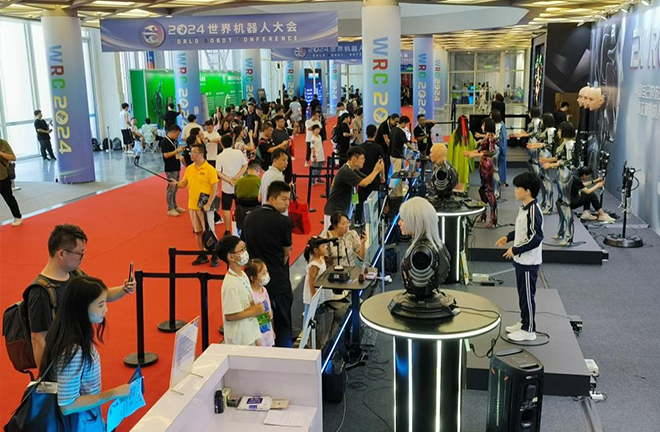Robotics industry presents fresh look

The World Robot Conference in Beijing in late August Photo: Sun Meijuan/CSST
At the 2024 World Robot Conference, robots demonstrated a wide range of skills, from flipping pancakes and making hamburgers to folding clothes, playing the piano, and even performing somersaults. Held from August 21 to 25, the event drew large crowds as robots showcased their impressive abilities, captivating both journalists and spectators.
Golden development stage
Although the term “robot” and the invention of the world’s first industrial robot are relatively recent developments, the human fascination with creating robots dates back much further. According to the Chinese text of Liezi, a skilled craftsman named Yanshi in the Western Zhou Dynasty (c. 11th century–771 BCE) invented an automaton that could sing and dance. Similarly, in ancient Greek mythology, the bronze man Talos was tasked with guarding his homeland. With the rapid development of artificial intelligence (AI) and robotics, these ancient dreams have become reality. Today, robots in various forms are building a wonderful world of human-machine integration and serving as key tools in driving the intelligent transformation of our economy and society.
In recent years, China’s robotics industry has developed vigorously, with continuous innovation in core technologies. As of July 2024, China holds more than 190,000 active robotics-related patents, accounting for about two-thirds of the world’s total. Additionally, China has been the world’s largest market for industrial robots for 11 consecutive years. Xin Guobin, vice minister of Industry and Information Technology, affirmed that after a decade of rapid growth, China’s robotics industry has grown into a significant force in the global robotics industry.
Beijing, leveraging its role as an international hub for technological innovation, has made significant strides in advancing the robotics industry through the implementation of a series of action plans, including the “Beijing 14th Five-Year Plan for high-precision industries,” to accelerate innovation in the robotics sector. Jin Wei, a member of the Standing Committee of the CPC Beijing Municipal Committee and vice mayor of the capital, noted that robotics is a strategic and pioneering industry for achieving high-quality development in the capital in the new era. In 2023, Beijing’s robotics industry generated over 20 billion yuan in total revenue, with more than 400 companies in the sector, including 50 “little giant” enterprises specializing in niche, advanced fields—leading the nation in this category.
Humanoid robots
The development and manufacturing of humanoid robots is widely recognized as one of the most technically challenging fields in the industry. So why do we invest extensive time and energy into researching humanoid robots? Qiao Hong, chairman of the World Robot Cooperation Organization and academician of the Chinese Academy of Sciences, explained that humanoid robots are characterized by versatility and intelligence, allowing them to seamlessly use human tools. This adaptability expands and deepens their range of application scenarios, promising to profoundly transform human production and lifestyles, usher in a new stage of intelligent development, and bring disruptive changes to a variety of industries. In the future, humanoid robots will be widely deployed in the industrial sector, handling hazardous tasks to greatly enhance production efficiency and safety. In specialized fields, they will be crucial for performing tasks in extreme environments, such as scientific research and exploration, rescue and disaster response, and security inspections. In everyday life, they will become an integral part of households, providing services ranging from domestic help to medical assistance, becoming increasingly indispensable.
Despite the immense challenges involved in developing humanoid robots, China has made several groundbreaking advances in this field in recent years. For example, Beijing Embodied Intelligent Robot Innovation Center Co., Ltd. unveiled “Tiangong,” the country’s first general-purpose humanoid robot platform and the world’s first full-sized, fully-electric humanoid robot capable of running. Similarly, the Chengdu Humanoid Robot Innovation Center has introduced China’s first Raydiculous Robot Multimodal Model (RRMM) and Raydiculous Two-Arm Cooperation System (RTACS), laying a new foundation for core technology breakthroughs.
According to Rick Xiong, general manager of Beijing Embodied Intelligent Robot Innovation Center, recent technological progress has significantly improved humanoid robots in areas such as intelligence, interaction, and movement. However, the development of humanoid robots is still in its early stages. Although many robots can now run, jump, and even perform somersaults, enhancing their stability, reliability, and applicability is essential before they can be seamlessly integrated into the dynamic scenarios of daily life and work. In addition, establishing regulations and laws specific to humanoid robots is crucial to ensure their design, development, and application align with human moral and ethical values. Such measures will safeguard the rights and safety of individuals employing humanoid robots, ultimately bringing greater welfare and convenience to society.
“Looking ahead, humanoid robots will develop in 10 key directions, including exclusive parts and materials, AI-empowered design, motion intelligence, and multi-modal large models,” Qiao continued. Regarding motion intelligence, humanoid robots are expected to attain three main capabilities in the future. First, they will be able to walk on complex terrain. They must be able to adapt to the complex terrain and narrow environments designed for humans such as slopes, stairs, and thresholds, while maintaining stable, adaptive, and disturbance-resistant movement. Second, they should be competent in dual-arm coordinated operations. In the case of lower body instability, they should be able to complete high-performance operational tasks through dual-arm coordination using human tools and equipment. Third, when hardware performance is poor and sensor information is scarce, their operating software should compensate, seeking and making full use of the environment and available data to make up for hardware shortcomings, ensuring high-level task execution.
Edited by YANG LANLAN
